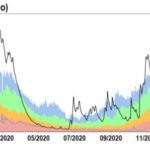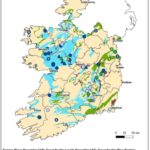The National Hydrology Bulletin for January 2021 is now available…
Hydrology Summary Bulletin – November 2021
Following the driest November in 80 years on the east coast, river flows, lake and groundwater levels are generally lower than normal for this time of year.
Almost all monthly rainfall totals were below average compared to their long-term averages for
November, and particularly dry spells were observed in the east of the country. This is reflected in
the river flows with all monitored rivers observing below the long-term average throughout
November. Two-thirds of river monitoring stations were in the ‘below normal’ category for this time
of year. Similarly, for lake level monitoring stations, 59% were in the ‘normal’ and 30% in the ‘below
normal’ category for average lake levels in November across the country.
Albeit average groundwater levels increased at 60% of groundwater monitoring stations between
October and November 2021 across the country, the largest proportion (43%) of station observed
levels ‘below normal’ for November averages. ‘Particularly low’ groundwater levels for this time of
year correspond largely to the eastern half of the country. Most of the monitored spring flows were
also below average monthly flows for November.
River Flows
November river flows remained similar at most monitoring stations compared to average flows
observed in October 2021. However, the monthly average flows are below the long-term monthly
average for November for all main rivers across the country. Analysis of monthly average flows at
164 river monitoring sites across the country identified; 1 (1%) ‘above normal’, 44 (27%) were
‘normal’, 102 (62%) were ‘below normal’ and 17 (10%) were classed as ‘particularly low’ for this
time of year. The Glenaddragh River (37020 Valley Br. monitoring station) in Co. Donegal is the only
station with flows observed as ‘above normal’ where the highest total monthly rainfalls for
November 2021 were recorded.

Lake Levels
Average lake levels were higher at 57% of monitored lakes compared to levels observed in October. Average lake levels at 44 lakes were classified as ‘particularly high’ at 1 (2%) [L. Muckno, Co. Monaghan {2}] , ‘above normal’ at 2 (5%), ‘normal’ at 26 (59%), ‘below normal’ at 13 (30%) lakes and ‘particularly low’ at 2 (5%) [L. Skeagh, Co. Cavan and L. Bane, Co. Meath/Westmeath], for the month of November.

Groundwater levels and spring flows
Average groundwater levels increased between October and November at 60% monitoring wells analysed. November groundwater levels were classified as ‘particularly high’ at 5 (13%), ‘normal’ at 8 (20%), ‘below normal’ at 17 (43%) and ‘particularly low’ at 10 (25%) monitoring wells across the country. ‘Particularly low’ groundwater levels are observed in the eastern half of the country.

Spring outflows were also monitored at 10 EPA monitoring sites. The outflows from these springs were compared to previously recorded flows for November, and 3 springs were ‘normal’, 6 were ‘below normal’ and 2 springs were ‘particularly low’ for this time of year.







